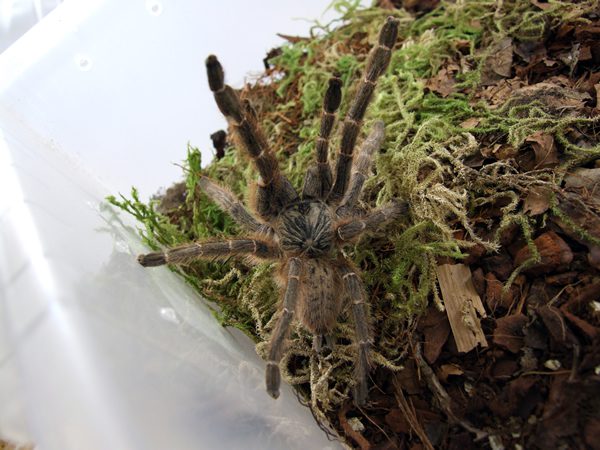Pterinochilus murinus (TCF)
Usamburu Baboon (6-8cm)
POCOCK, 1987
Species Info:
Origin
Lifestyle
Temp
Humidity
Leg Span
Disposition
Suitability
This is the most popular African Tarantula in the hobby and for good reason. The colour of the this species varies depending on original locality. They vary from a beautiful bright orange colour to tan with a starburst pattern covering its body. It is very interesting in both its behaviour and habits. Not a beginners species but definitely one of those species you need to keep sooner or later. They do not require high humidity and can be kept on slightly moistened substrate with a water dish. They are best kept in a terrarium that is set up with both arboreal and terrestrial hides. If given enough substrate they may even dig a burrow. They are very heavy webber’s and will not only cover a dense layer of web over their retreat but also over the entire enclosure, establishing elaborate silken tunnels. Care needs to be given when moving them and maintaining the enclosure as they are very fast and will not hesitate to bite or escape.
This is the species has the widest distribution of all African species. There are four main colour forms, each of which differ slightly in colour and pattern: typical (TCF), red (RCF), Usamburu mountain variant (UMV) and dark (DCF) which isn’t available in the hobby yet. Each form differs in not only their colour and habits but also size. The biggest form is the “TCF” – males have been recorded reaching 18cm LS. The “RCF” (also often sold under “trade” names like Pterinochilus sp. “Usamburu” or P.spinnifer or P.mamillatus) usually construct their silk shelters above the substrate where as the others are more terrestrial and will utilize terrestrial hides or burrows. In the wild it inhabits humid and semi -humid equatorial as well as arid bush land and semi deserted areas, with an altitude range between sea level to 2100m. They live in burrows, holes and utilizes other natural refugees on the ground, on the base of bushes, between stones and sometimes in the hollow of trees.
<
This species is often bred in captivity and spiderlings are available through out the year. Females are not very productive and produce fixed eggsacks which contain around 120 – 150 eggs, however this species unlike many other Tarantulas can produce 2 or 3 eggsacks from one mating. Offspring are very good eaters, they will tackle fast prey and are fast growing.

